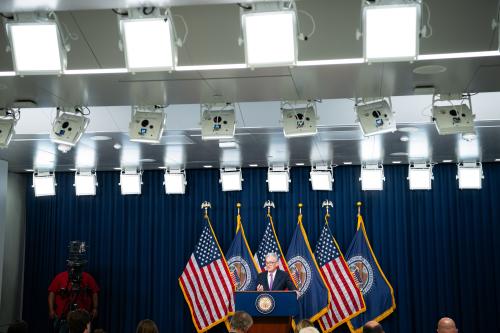Editor’s note: This post originally appeared in the Wall Street Journal Think Tank blog on May 13, 2015.
One of the most peculiar features of Federal Reserve governance–and perhaps the hardest to defend in a modern democracy–is the structure of the regional Fed banks and the role of their presidents in making monetary policy.
But the draft bill offered by Senate Banking Committee Chairman Richard Shelby (R., Ala.) avoids nearly all the tough issues of legitimacy that surround the regional banks.
First, a bit of background. In a 100-year-old anachronism, the 12 regional Fed banks aren’t government entities; legally, they’re owned by the commercial banks in their districts. By law, bankers pick six of the nine members of the board of directors of each bank; three must be bankers and three must not be. The other three directors (who can’t be bankers) are chosen by the presidentially appointed Fed Board of Governors in Washington. The six non-bankers on each regional Fed board pick the bank presidents, subject to the approval of the Washington governors.
In practice, those private-sector boards don’t have a lot of power, but they do have substantial influence in choosing the presidents. And those presidents have a substantial role in making monetary policy. All 12 participate in monetary-policy discussions; five of them have a vote at any one time.
The decentralization of the Fed has its virtues. With their bases outside Washington and their independent research departments, regional Fed bank presidents bring different perspectives and a diversity of views to Fed deliberations. The problem is one of legitimacy (and, to some, legality). It just doesn’t seem right to have important public policy decisions made by private-sector players. That’s a particular problem at a moment when the Fed is the subject of such skepticism and scrutiny. It fuels the narrative that the Fed is captured by financial and business interests.
And it’s downright weird that the president of each of the 12 Fed banks is paid far more than the Fed chair in Washington, who is a government employee. The Fed chairwoman earned $201,700 last year, and the other Fed governors earned $181,500. Salaries of the 12 bank presidents, who are not government employees, ranged from $281,300 to $410,780 in 2013. (See Table 13 here.)
The regional Fed bank presidents are very popular with Republicans in Congress these days. The Shelby bill would reinforce their role in an era when the Fed is relying on new monetary tools by changing the law to make clear that all major monetary decisions must be made by the Federal Open Market Committee, on which the presidents sit, not by the Board of Governors alone.
The bill would create a commission to ponder the Fed’s structure but then tells the panel to avoid the big questions. The seven-member commission is to consider restructuring the Fed system but with a narrow charter: whether to recommend an increase or decrease in the number of Federal Reserve bank districts and the distribution of duties among the regional banks and between the regional banks and the Board of Governors.
It doesn’t touch questions raised by the archaic ownership structure of the Fed or the discomfort caused by having nominally private companies making public-policy decisions–with one exception. It would make the head of the New York Fed a presidential appointee, arguing that post is too important not to be confirmed by the Senate. (The bill doesn’t make clear whether that means he or she would have to take a pay cut.)
The boundaries of the Fed districts, drawn a century ago, are out of date. Having one Fed bank west of the Rockies and two in the state of Missouri is hard to defend. Twelve Fed banks may well be six or seven too many. But if we’re going to have an independent commission to ponder all this, ignoring the bizarre and outdated governance of the system is a missed opportunity.



Commentary
Op-edFed regional bank issues the Shelby bill doesn’t address
May 13, 2015